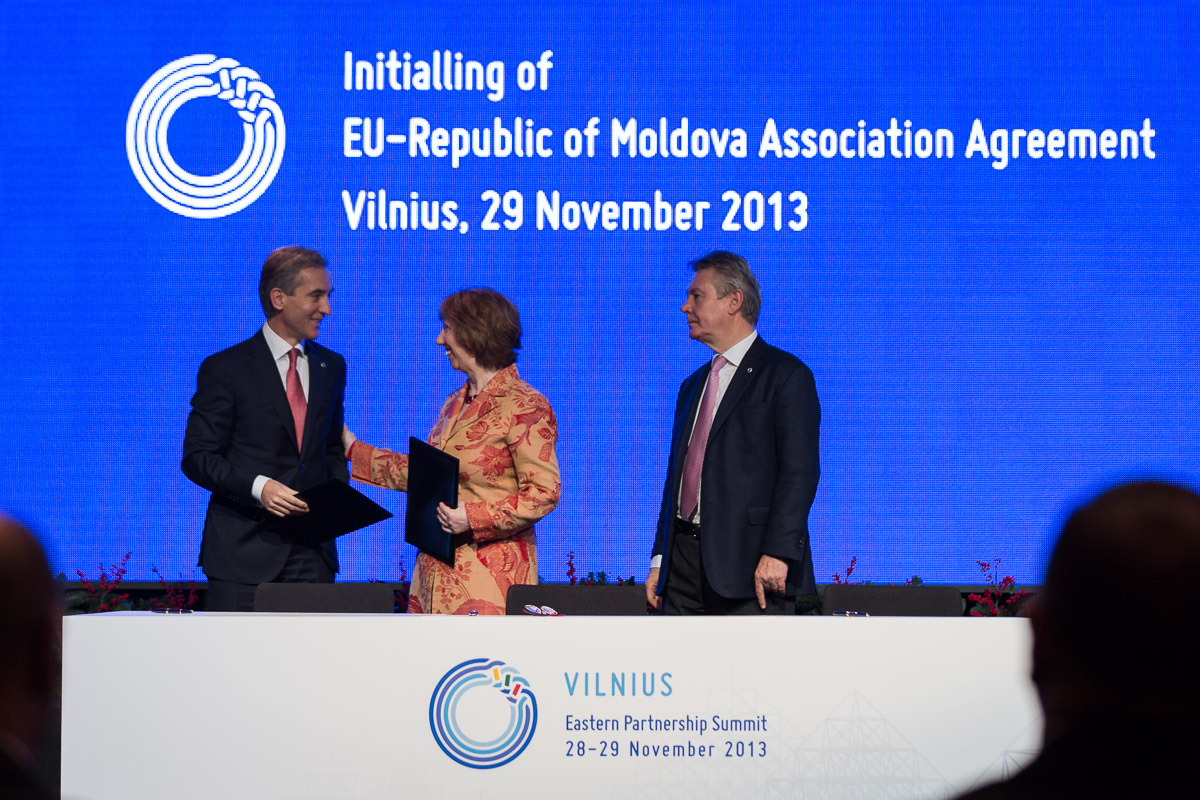
Moldovan Government Moves Closer to the European Union at the Vilnius Summit
Publication: Eurasia Daily Monitor Volume: 10 Issue: 218
By:

Among the European Union’s six Eastern Partnership countries (Belarus, Ukraine, Moldova, Georgia, Armenia and Azerbaijan), Moldova is moving closer to the EU at the fastest pace. The government, led successively by Vlad Filat (prime minister, 2009–2013) and Iurie Leanca (foreign affairs minister 2009–2013, prime minister since May 2013), has put Moldova in the lead during this team’s four years in office.
On November 28–29, the European Union and Moldova signed an Association Agreement (AA) and a Deep and Comprehensive Free Trade Area (DCFTA) agreement at the EU’s Eastern Partnership summit in Vilnius, under the EU’s Lithuanian presidency.
Also at that summit, the European Commission officially confirmed Moldova’s successful implementation of the EU-Moldova Visa Liberalization Action Plan (VLAP); and it recommended to the European Parliament and EU Council (represented by member countries) to allow visa-free travel for Moldovan citizens holding biometric passports.
The EU’s High Representative for Foreign and Security Policy, Catherine Ashton, and European Trade Commissioner Karel de Gucht signed the AA and DCFTA with Moldovan Prime Minister Iurie Leanca and Deputy Economics Minister Octavian Calmic, respectively. The aggregate document (the free-trade agreement forms part of the association agreement), totaling almost 1,000 pages, has now been declassified and made public (Unimedia, December 2).
The two agreements define the terms of Moldova’s political association and economic integration with the European Union at the current stage of an advancing process.
At the signing event in Vilnius, Prime Minister Leanca characterized Moldova’s European integration policy as a direct continuation of Moldova’s 1991 decision to separate itself from the Soviet Union and become an independent state. Leanca also cautioned that Moldova’s choice would only become irreversible if and when Moldova earns the status of an EU candidate country, entailing the prospect of accession to the European Union (Moldpres, November 29, 30).
The European Commission and European Parliament are likely to fast-track the implementation of the visa liberalization and free-trade agreements with Moldova: the visa liberalization set to go into effect during the first half of 2014, the free-trade agreement during the second half of the same year (see below).
Thanks to the visa liberalization agreement, Moldovan citizens will enjoy freedom of movement within the EU’s Schengen area. As a collateral effect, fewer Moldovan citizens will need Romanian passports as a stratagem to enter the EU. Conversely, Moldovan passports will become significantly more attractive to residents of Transnistria, compared with the Russian or Ukrainian passports.
Moldova stands to receive broader access to EU grants and credits, technical assistance, and largely free access to the EU market for Moldovan export products. Moldova will become more interesting for foreign investors, both from the EU and from outside the EU, attracted by the opportunities to produce in Moldova for export to the EU.
A distinct risk arises that Russian investors could rush to Moldova and snap up local companies, ahead of EU investors. Moldova must not adopt, and the EU should not demand, a laissez faire attitude toward Russian takeovers of Moldovan assets.
From 2009 onward, the Filat-Leanca governmental team has led those institutions (prime ministership and state chancellery, the foreign affairs, internal affairs and justice ministries, border protection service) that bore the brunt of the political and technical work to qualify Moldova for association with the EU. This team negotiated the association and free-trade agreements, introduced the EU-required biometric passports, implemented the visa-liberalization plan, overhauled the border protection service, acceded to the EU air space regulatory system, and pushed the EU-required anti-discrimination legislation through the parliament.
It also spearheaded the drafting of the justice reform concept, the anti-raider legislation, and decentralization plan for the local public administration. These await implementation against resistance from vested interests, mainly within the coalition government. The government in office since 2009 is a nominal coalition of three rival parties. Filat and Leanca’s Liberal-Democrat Party often encountered resistance from the other two coalition partners—the Democratic Party and the Liberal Party.
The Democratic Party’s leaders, Marian Lupu (formal leader until May 2013) and billionaire Vlad Plahotniuc (de facto leader), have frustrated the reform of the justice and law enforcement systems, in which this group holds, since 2010, most of the key posts. This party’s leadership displayed, at times, a “Euroskeptical” attitude, and in April 2013 it joined forces with the Communist Party in parliament to bring down the Filat government. Liberal Party leader Mihai Ghimpu and officials from that party came out against the anti-discrimination legislation, the liberalization of the air travel market, and the DCFTA. The Liberal Reformer Party split off from the Liberals and replaced them in the government since May of this year.
In the context of the Transnistria conflict, the DCFTA (along with the more attractive Moldovan passports—see above) can generate some “soft power” for Moldova. At the Vilnius summit, and in Chisinau afterward, the government has announced that it would redouble efforts to persuade Transnistria’s political authorities and business circles to take advantage of the DCFTA’s benefits. Transnistria’s producers and exporters are entitled to be included in the Moldova-EU free-trade area, which Moldova will join in September 2015 (Unimedia, December 1, 2).




